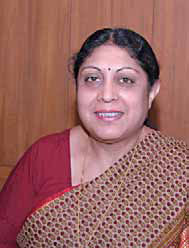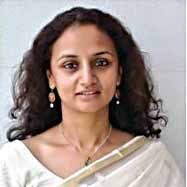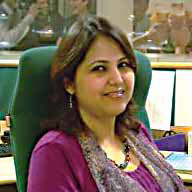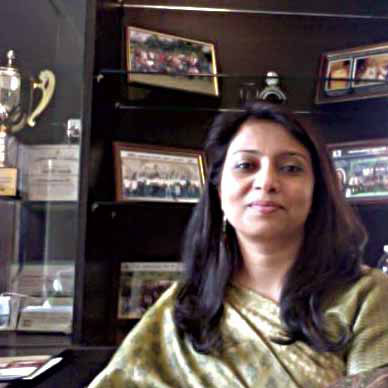Corporate Culture : Women In Leadership Pride Of India Inc!
IT WAS IN THE YEAR 2013, A LAW WAS PASSED,
MAKING IT ESSENTIAL FOR CORPORATES TO HAVE
AT LEAST ONE WOMAN ON THEIR BOARD, WHICH
HAS MADE AN IMPACT TODAY
Overcoming all negative notions, the new generation women
have proved themselves even in uncharted waters. Back in 2013,
India passed legislation for any company that was listed on the
stock exchanges, making it essential to have at least one woman
in their board of directors. It was a landmark law, given that at
the time, more than two-third publicly traded companies in
India did not have women board members. It is well known
that women, despite starting their careers with equal levels of
intelligence, education and commitment, were not making it
to senior management positions as much as their male counterparts did. While things today
may appear differently, has there really been a shift in attitudes?
A panel discussion, chaired by Veena Swaroop, Director HR, Engineers India Ltd, delved
deep into the issue of women in leadership. Burning topics, such as the presence of glass
ceiling in organisations, merit versus reservation for career advancement, and the lessons for individuals as well as organisations to further the
cause of women, were freely discussed. The panel
consisted of noted members of the HR diaspora
from various organisations, including Vishpala
Reddy, VP, Market HR India, American Express;
Seema Bangia, Head HR, Mahindra Defence
Systems Ltd; Shalabh Mundra, Vice President,
UltraTech Ready Mix Concrete Division, Aditya
Birla Group; and Simin Askari, Vice President
Corporate HR, DS Group
What made the session truly interesting were
the probing questions Ms Swaroop asked to each
panellist.
These included:
- How is diversity of thought due to women
employees impacting organisations? We oft en
hear that there is a glass ceiling. What do you
think, is there really a glass ceiling?
- What initiatives have been taken at your
organisation to facilitate women improvement?
- How do you perceive women employees
vis-a-vis men employees?
- Statistics show that till the middle levels we
have 40% women and if we reach higher levels,
it comes down to 8 per cent. What can we do to
retain women beyond the middle levels?
- What advice would you give to the
audience on how they should help women rise
in their career?
The discussion brought in a variety of views,
describing both, the achievements as well as
the pain-points, endeavours being pursued at
different stages to support women, as well as areas
that still needed intervention. Read on to know
Ms Swaroop’s opening remarks, and answers by
each panelist to her above-mentioned questions
Glass ceiling is not a physical reality, but rather
a virtual one. Th e data and statistics prove that.
The good news is that working women have now
realised that if they start asking, begin to have
an open mind, develop risk taking ability, then
they will succeed. It is like a two-way course. As a
result, there is a change happening
VEENA SWAROOP (VS)
Director HR, Engineers India Ltd
- Corporate diversity is the force multiplier and
a game changer for growing organisations.
Diversity brings in different perspectives to the
table. Girls are being encouraged to join the
B-schools so that the classrooms would have
more variety in thoughts. Having said that, why
is this issue being researched so much around
the world?
- We generally talk about it only in women’s
conferences, are we not stereotyping this too?
Stereotyping female roles starts right from
childhood. This attitude needs to be contained.
Women are not present in senior position in
companies, because they began very late. Until
my mother’s generation, women would not work
outside households. Today, I find both husband
and wife are working. So, things are changing,
and I’m optimistic that the future will see many
more women at top positions.
- I believe that we don’t need any bogus
system or false criteria for rising in positions.
Organisations work on bottom line results, so if there is a good performer, why would
anyone want to deprive that performer of good
assignments? Prior to the EIL, I was working in
ONGC. The ONGC has 14% women - very high
for a public sector company. Some of the women
are the best process engineers, instrumentation
engineers and commissioning engineers at
ONGC. Their work speaks for them. So, women
need to have the confidence in themselves.
- I think the public sector is a little better off . We
have a written test where both the girls and boys
perform to the best of their abilities. Very oft en
we find an equal number of girls and an equal
number of boys coming up. We identify the best
performer who is going to take the organisation
forward. Th e objective is: let the best person win,
be it a boy or a girl. But to have this kind of a
vision, the mindset of both the men and women
need to change fast.
VISHPALA REDDY (VR)
VP, Market HR India, American Express
- Organisations understand that diversity in
no longer a legacy. There is a scientific proof as to why it is important to have diversity in teams.
However, the difference is in terms of confidence
levels. If you ask a male boss, “can you make it to
the top?” research suggests, 76 per cent of them
would say yes. But when the same question is
asked to women, 50 per cent reply with “maybe”.
When a new job is internally available, men
would speak to their supervisor even if they
possess only 70 per cent of the skills needed for
the job. But woman will hesitate unless they have
100 percent skills needed for the job. Men will
ask when they need an appraisal. Women will
hesitate. So there’s a lot that women themselves
can do. But the organisation and the leadership
have a role to play too.
- Glass ceiling is not a physical reality, but
rather a virtual one. Th e data and statistics prove
that. Th e good news is that working women have
now realised that if they start asking, begin to
have an open mind, develop risk taking ability,
then they will succeed. It is like a two-way course.
As a result, there is a change happening.
- At American Express, we take diversity very
seriously. We have a lot of onsite activities where
we provide for our employees, including on site
clinics, and pregnancy care programs. We have
an extremely active Women Interest Network,
which is spearheaded by senior members of the
organizations. Th e network develops as well as
projects women across the organization. We work
on creating ‘readiness’ in our women employees
for their potential, and for this purpose we don’t
just have day or week-long programs, but also
programs with longer gestation periods. We
also connect women not just internally but at an
external forum as well. Collaborations with other
Ivy League organizations have helped them learn
from each other’s best practices. We are providing
many platforms to our high potential women
employees, and I think it’s working for us.
- At American Express, we have been
introducing our senior women leaders to the
concept of sponsorship. Sponsorship is one step
beyond mentoring. Th rough a mentoring set up,
the women employees meet the sponsors once
in a month or two. A sponsor is someone who
can vouch for the work ethic and reputation
of a colleague. A sponsor is interested in the
individual’s work achievements. One cannot
just go up to somebody and ask that person to
be a sponsor. Sponsorship should be earned.
Sponsorship happens if you are good and if you
are working extremely hard. You will encourage
that person to build a network around her and build relationships. Th ere are rules so that
those who are sponsors and those who are
getting sponsorships, have a role to play. It is
not a one-way relationship. I think the concept
of sponsorship is very important and we very
oft en see our senior most women say that it is
not enough to just have a boss or your direct
supervisor as your sponsor, but you should be
looking at multiple sponsors, who could be
external to the organization or internal. But
mostly it should be people who are in a position
to influence. Often in talent conversations, that
push makes a big difference. Th e one voice on
the table who would say with conviction that this
person can make a difference.
- From an organization’s standpoint, the
key thing should be measurement. The diversity
ratio at certain levels is more and at other
levels it is less. It is really a business leader’s
metrics and not an HR metric. More than just
representation, the metrics can mean that a
certain percentage of diversity is required for
different roles. From an employee’s standpoint,
it is not about differentiation between men and
women. It is about creating an inclusive culture,
and encouragement to women. We need to not only connect people, but also share their success
stories as well as their challenges. We sometimes
overlook simple things like that
Seema Bangia (SB)
Head HR, Mahindra Defence Systems Ltd
- “Equal opportunities” is a common phrase
in companies right now. But equal participation
of women and men in decision making processes
at all levels needs to become the norm. Mahindra
& Mahindra is a large conglomerate with about
2.25 lakhs of people across sectors. I come from
Mahindra Defence. It’s a male-dominated sector
and I was one of the few women who joined the
organisation back in the days but I believed HR
processes remain constant wherever you go.
In the last few years there has been an increase
in women employees. We now have about 5%
women, and this paradigm shift happened
because of the organisation’s efforts.
- Our CMD is none other than a woman, Ms
Anita Vikas. We encourage more women at the
executive board level. But, we need to encourage
more women also at mid managerial levels. I
agree with my co-panellists who said it should be
performance-centric rather than woman-centric.
For that we need a conducive environment to be
created. So that when women are performing,
they are recognized for that performance
- People in many organisations have really
gone out of their way to support the gender
diversity initiative. A well-known car brand has
once-a-week grocery market for employees on
their campus. Some of these organisations are going overboard also. But at Mahindra, we have
taken a very balanced approach. We have the
usual things like extended maternity benefits,
but other than that, every policy is the same for
both genders.
- We also identify women employees who
work very hard and have the urge to walk the
extra mile. After we identify them, they go
through a mentoring process by participating in
various forums with which we have tie ups.
- As I said earlier, I think a lot of efforts and
initiatives are being taken by the organisations
and now it is up to the women employees to
take that forward. Women should come out of
their comfort zones and say that yes, we can do
it. To give a specific example, we have hired a few
women employees who like to work in a male dominated
industry like ours. With the focus
on ‘Make in India’ initiative, this is the time for
women to evolve and walk that extra mile.
Women are not present in senior position in
companies, because they began very late. Until
my mother’s generation, women would not work
outside households. Today, I find both husband
and wife are working
We need to take a step forward. We need to
understand that a woman may have issues at
home which would affect her performance. It is
important to not penalise them for that
SHALABH MUNDRA (SM)
Vice President, UltraTech Ready Mix
Concrete Division
- Most women start out with great merits,
but due to lack of support in the system or in their
families they tend to go slow. This is happening
in the sector where I am working. We have been
working for last many years in cement, readymix
concrete and construction sectors. While
traditionally, it has been dominated by men, in
the past decade itself, many women engineers
and planners have joined the planning and
design sections. We are also having women coming from different places working in
construction sites and in tough and difficult
environments. Going forward, the situation will
become like China, where majority of the design
and quality managers are women. The challenge
for companies, however, is how do we initiate
systems which nurture and support women.
- First of all, we try to get the right talent
in the right position, irrespective of the gender.
So, in case we have women for difficult jobs,
we are creating systems so that the actual work
becomes easier. When I talk about our businesses
in apparel sector and retail, the percentage of
women placed in these sectors is high. When
it comes to manufacturing, the increase which
is happening is slow. Although the sectors are
different, there will be a gradual increase in the
years to come
- We are focusing a lot on increasing
recruitment of women in functions like HR,
finance, corporate communications and also
taking women from engineering colleges to work
in factories and shop floors of our manufacturing
facilities. In the cement industry, we have
increased the diversity in our sales force and
have more women working in sales, customer
support, and some have graduated to become the
in-charge of a city. So, we are gradually seeing the
improvement happening.
- Apart from the fact that companies are
doing a lot for women, women themselves need
to step up. After working for 8 to 10 years, they
tend to take it slow due to lack of support. So
that is where they need to make great efforts.
Lots of women were in that stage of life where
they were under pressure or anxiety, but have
risen to senior leadership positions despite those
stresses. So this is one area which I feel would
help women grow from middle level to senior
leadership positions.
- One major point I would like to make is that
organisations are supporting women in various
ways, but women themselves need to become
more determined to prolong their careers
SIMIN ASKARI (SA)
Vice President Corporate HR, DS Group
- When we talk about leadership qualities,
most of them are masculine in nature. Women are
stereotyped as emotional, non-aggressive and soft
spoken. I see a lot of organisations trying to bring
in more women in their workforce. There are now
regulations in place which mandate the presence
of women board members. But such reservation breeds discrimination and I am not in favour
of it. In most Indian organisations, the scrutiny
on the performance of women is probably a
little harsher than that of men. Obviously, I am
happy to see more women in companies, but
that is not necessarily the end of this discussion.
Organisations need to hire women not merely
because they are women, and not merely for
diverse views; it should be based on merit of doing
a good job. I am waiting for a day when we are
sitting around and talking about great leaders,
some of whom just happen to be women.
- You could say that there is glass ceiling to
a certain extent. But if you have the conviction,
if you have the will, if you have the competence,
there is nothing that is going to hold you back.
We don’t see a lot of women in the leadership
positions. It maybe because they are under a lot
of societal pressure, a lot of restrictions, a lot of
other responsibilities that they need to overcome
and perform with these pressures. And, that probably restricts them from rising further.
- We have a decent number of women in the
workforce, even in our manufacturing We have
policies which are gender neutral but specific to
women also. We find a lot of women in senior
leadership positions as well and we definitely don’t
discriminate based on gender.
- We need to take a step forward. We need
to understand that a woman may have issues at
home which would affect her performance. It
is important to not penalise them for that. We
have a group within our organisation who tries
to counsel women if they have performance
issues due to some problems at home, and how
we can handle that. But the fact is that it is up to
the women to be motivated enough, and try to
hang in there in spite of the cultural mindset of
the society.
- As HR leaders responsible for recruitment,
we must make sure that we ask the right
questions. If someone wants us to recruit only
male candidates, then we need to ask them for the
reasons behind such a requirement. Try and make
sure that there is equal number of women to be
evaluated for any particular role and then recruit
the best man or woman, based on competence. If
we do not even provide the opportunity, then we
cannot expect diversity to happen.
By PRIYANSHI MATHUR



